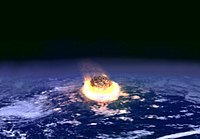
Photo from wikipedia
Abstract The Hell Creek Formation and overlying Fort Union Formation record a geologically rapid base-level rise that was approximately contemporaneous with the K/Pg extinction and deposition of Chicxulub-impact indicators. An… Click to show full abstract
Abstract The Hell Creek Formation and overlying Fort Union Formation record a geologically rapid base-level rise that was approximately contemporaneous with the K/Pg extinction and deposition of Chicxulub-impact indicators. An outstanding question that remains is whether this base-level rise is attributable to: 1) a multi-thousand-year transgression adjacent to a relatively low-relief coastal plain, causing a rise in the water table; or 2) catastrophic flooding due to upland denudation, rapid channel accretion, and hydrologic reorganization resulting from wildfires/deforestation consequential of the impact. Herein we aim to address which of these hypotheses is most consistent with a paleolandscape reconstruction at Mud Buttes, a locality where the boundary clay (BC) is coincident with the Hell Creek-Fort Union contact. One hundred twenty-seven trenches were examined laterally across ∼2 km transect of K/Pg boundary. The uppermost Hell Creek is comprised of three pedotypes: Pale-Silt Inceptisol (PSI), Olive-Clay Vertisol (OCV), and Chocolate-Clay Vertisol (CCV), which range from moderately well-drained, to variable to poorly drained, to very poorly drained, respectively. All of the BC occurs superjacent to the CCV, despite this pedotype accounting for only ∼50% of the pre-event landscape. The edaphic features preserved in the CCV pedotype are not attributable to Paleogene overprinting, which indicates that hydromorphic conditions began prior to the impact. Furthermore, 46% of BC is overlain by lignite, despite lignite occurrence on 17% of the earliest Paleogene landscape. This reveals that the poorest-drained landscape positions of the latest Cretaceous persisted across the boundary. These relationships are most consistent with a non-catastrophic base-level rise.
Journal Title: Cretaceous Research
Year Published: 2020
Link to full text (if available)
Share on Social Media: Sign Up to like & get
recommendations!